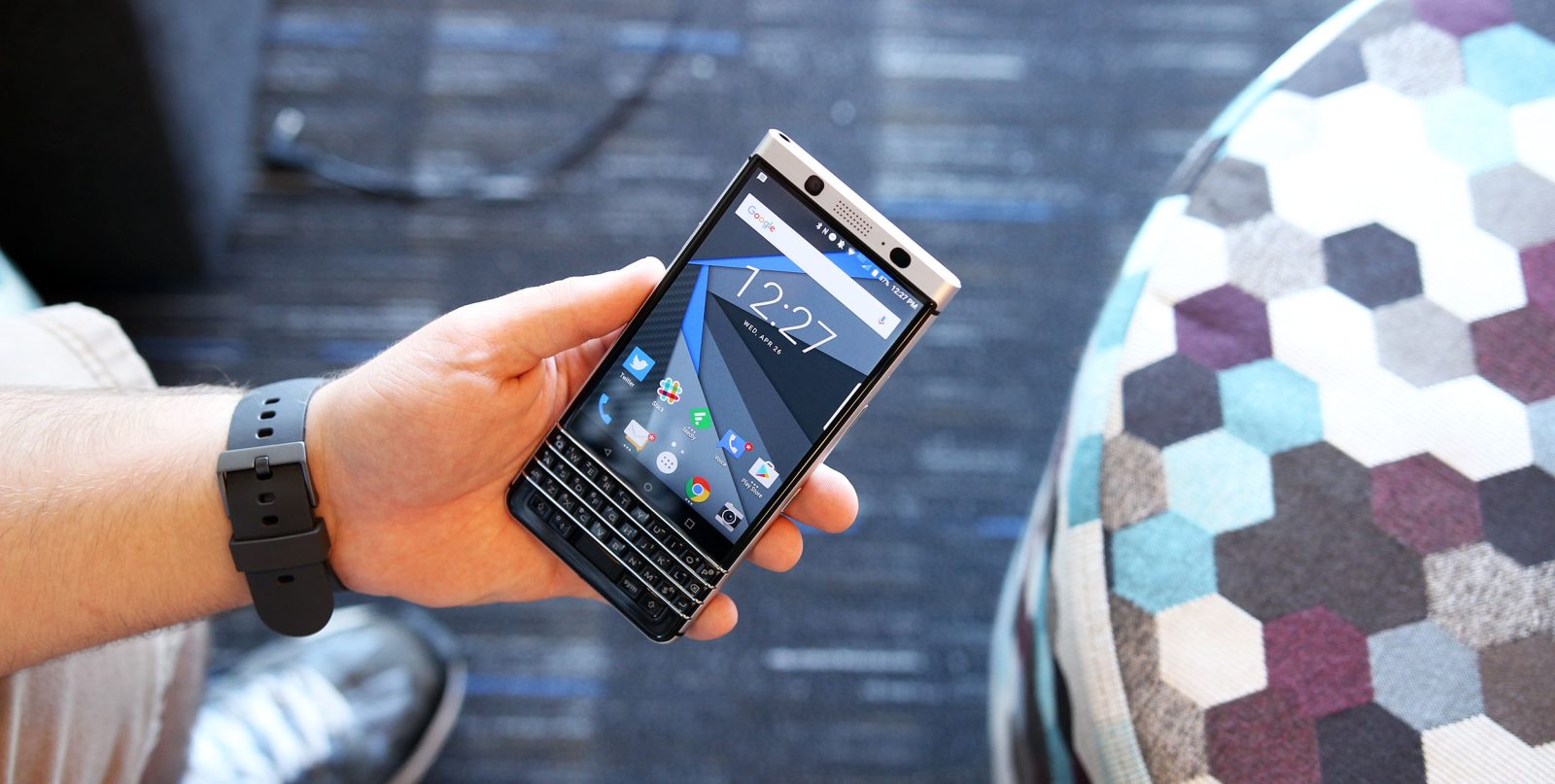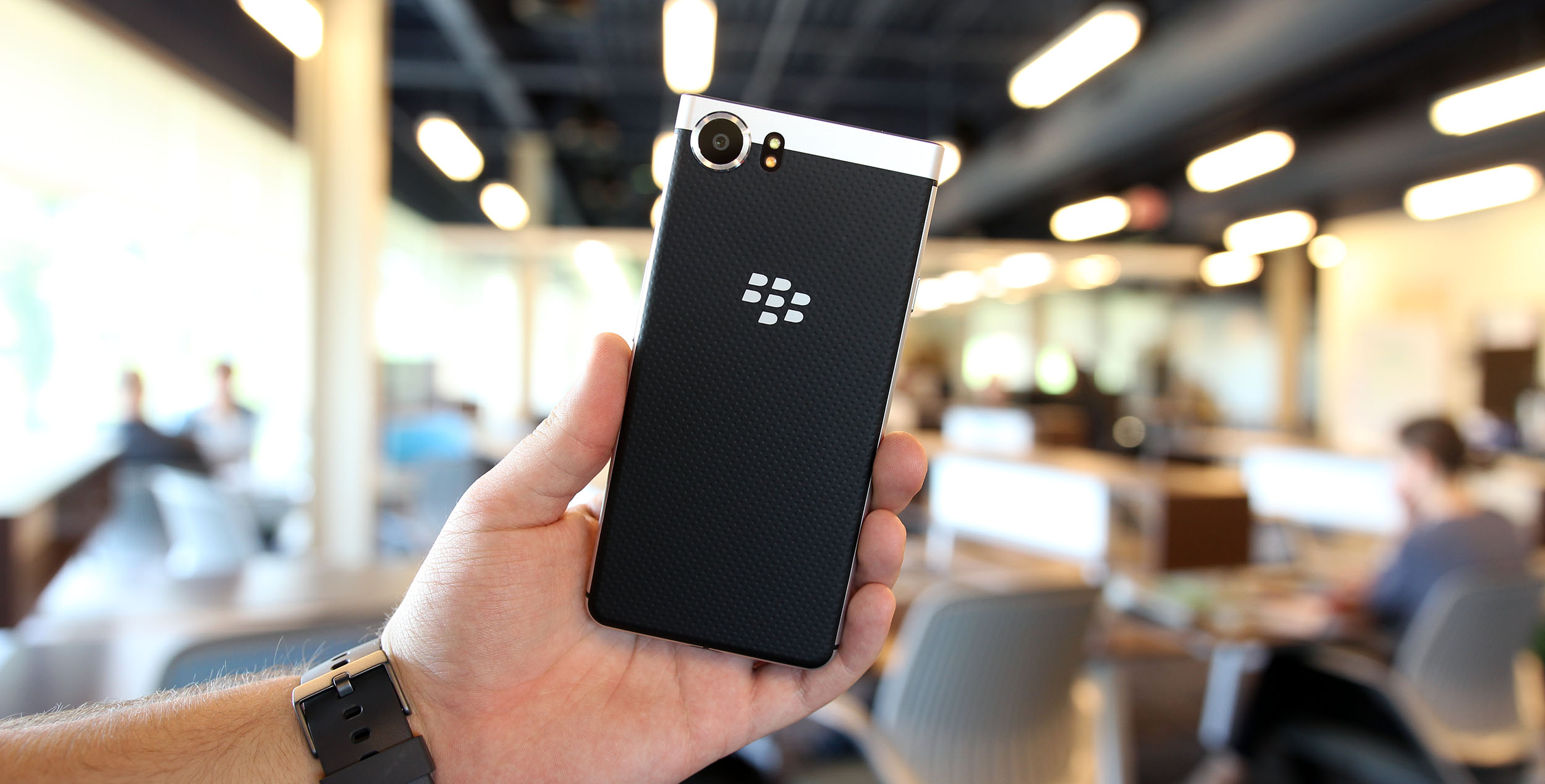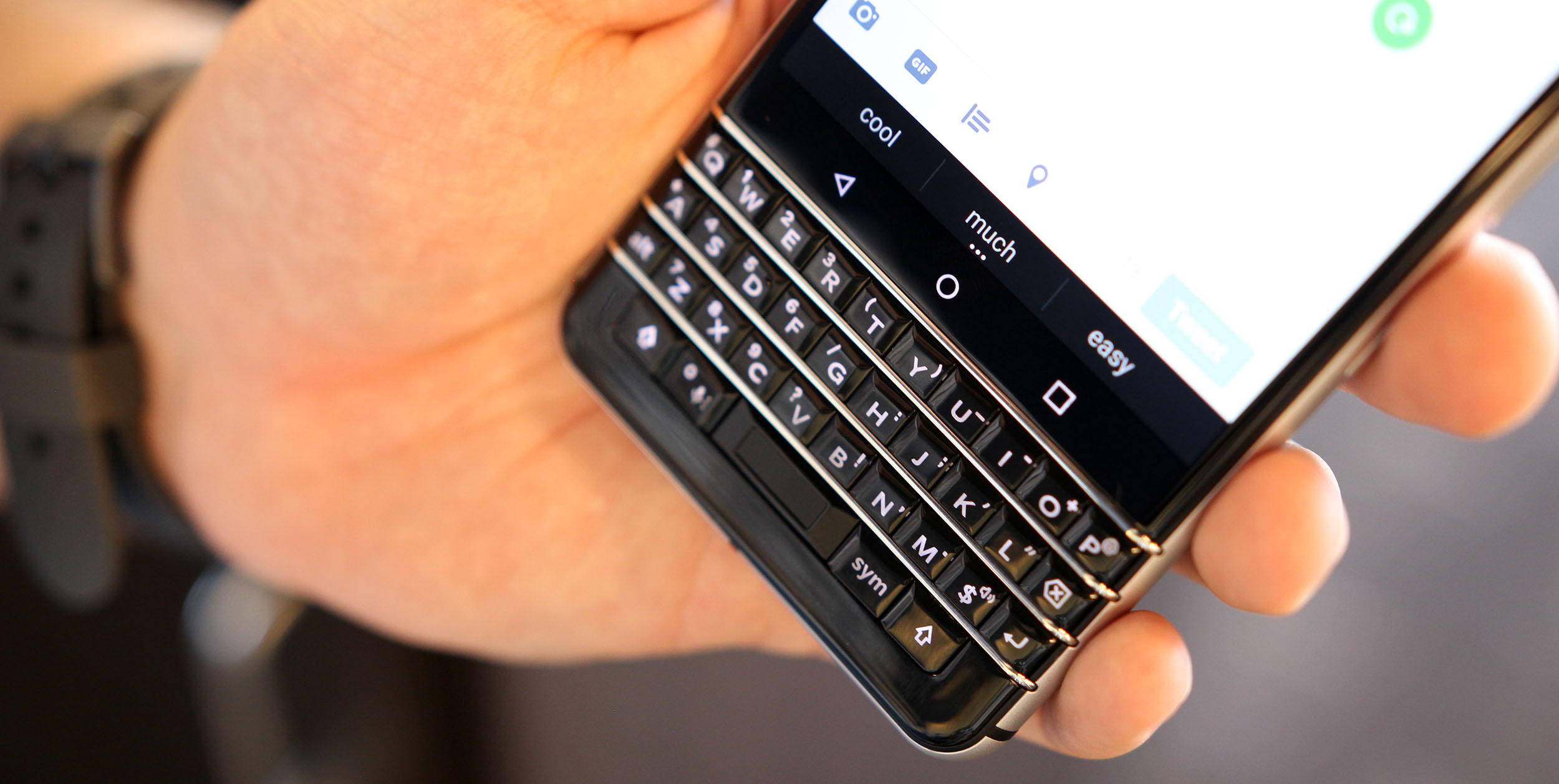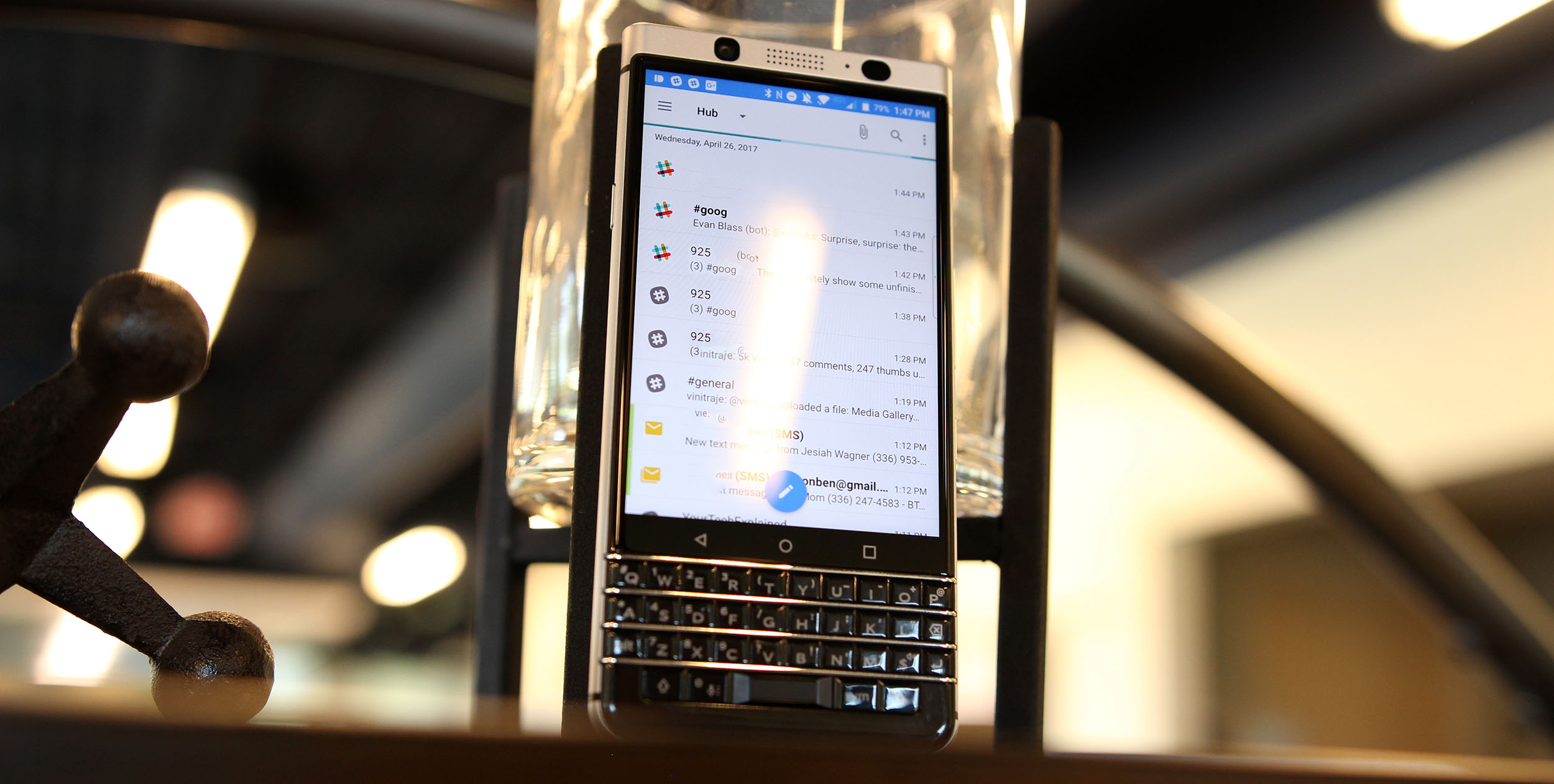
Smartphones have evolved a lot over the years. One of the biggest changes, though, came with the move in popularity from the BlackBerry to the iPhone. It was a jarring transformation, but there’s no question who got it right. Now, nearly a decade later, BlackBerry is a brand that is shocking to hear in the mobile industry, but it’s also one people still fondly remember.
In 2016, BlackBerry tried to make a comeback in the mobile space with the debut of the BlackBerry Priv, an Android-powered slider with a physical keyboard that, well, didn’t do very well. At CES 2017, though, BlackBerry took the wraps off of its latest project with TCL, now known as the Keyone. It made waves in the news as the return to form so many wanted from the company, and now it’s finally for sale. Should you buy it? Let’s take a closer look…
Comment: How BlackBerry fixed the Keyone ahead of its launch
Hardware |
An industrial design I can’t help but adore…
BlackBerry has never really had a smartphone design that grabbed my attention. Rather, the company has always gone for designs that get the job done without looking particularly bad, and the Keyone isn’t all that much different.
The design of the Keyone is as industrial as it gets, and I love it. The grippy rubber on the back and silver/black color scheme looks excellent, even if it isn’t something jaw-dropping like the Galaxy S8. That’s a good thing if you ask me, though, as it offers up a better experience in the hand. The phone is very hefty and a bit chunky, but it’s also not as fragile as most phones available today.

Really, the Keyone just looks and feels like a BlackBerry should, and I love it. Nothing about this phone feels cheap either, despite the fact that it’s not made of glass and metal like just about every other premium phone on the market today. The metal and rubber reminds me of the 2015 Moto X, but it feels even better in the hand if you ask me. That grip especially helps when you’re typing, but I’ll get into that more in a bit.
Display |
A change of pace that I have mixed thoughts about
Since the BlackBerry Keyone has a physical keyboard that’s always present, the company had two choices with the display. The first would have been to make a ridiculously tall phone, and the second and more reasonable was to use an odd and cramped aspect ratio. Needless to say, I think the company made the right choice by going with the latter.

The display on the BlackBerry Keyone is about 75% as tall as the display on the Google Pixel XL. At 4.5-inches, it seems small on paper, but side-by-side with the XL, it doesn’t feel small by any means. Using the phone one handed is a pleasure when you’re scrolling around the UI thanks to that size as well.
The quality of the panel is also pretty solid. The 1620×1080 IPS panel has good color reproduction and viewing angles, but I would’ve preferred to see the company stick with the OLED technology that was present in the BlackBerry Priv. Regardless, it gets the job done. Brightness would be my only major gripe, as it’s not all that easy to see this phone outdoors/in bright light.
Keyboard |
BlackBerry’s standout feature is excellent in a lot of ways, but it’s also not
It’s no secret that the biggest feature of the Keyone is the keyboard. Just like the BlackBerry devices of the past, this phone has a keyboard front and center, always ready to go. This is the main selling point of the Keyone, and it lives up to just about everything one would want it to.
The keyboard on the Keyone offers up a somewhat cramped, but very tactile and easy to use layout. Out of the box most people will need some time to adjust, but just a few hours of use is enough to be proficient. The keys are also very comfortable to press and offer up subtle backlighting that comes in handy in all situations. The layout also feels relatively natural, and I really love that the fingerprint sensor is hidden in the spacebar. One annoying thing about the placement, though, is that the capacitive navigation buttons are directly above the keyboard, leading to quite a lot of accidental taps.

I also can’t stress enough how much I love using the keyboard as a gesture pad. A swipe to any direction can play with most apps on the phone, and really comes in handy when scrolling webpages as you finger won’t block the text on screen. The added ability to use a key as an app shortcut is also a welcome addition. “Flick” typing for auto-complete is also excellent.
The main question I had to ask myself when using the Keyone’s keyboard was a tough one: Is this better than an on-screen keyboard? Through a week of using the Keyone, I racked up quite a bit of time typing on this keyboard and at this point, I’m fairly quick on it. However, I wouldn’t say I’m quicker than I am on a standard on-screen keyboard. Part of this is surely the amount of time I’ve used this medium, but the other is just how many steps back this technology is compared to an on-screen keyboard.
First off, on-screen keyboards are more flexible and can adjust based on what you’re trying to type. This can save countless keystrokes, and it also allows commonly used functions to be within a tap to access. On the Keyone’s keyboard, it’s harder to see where certain things are. Again, though, this is something that could be negated as one continues to use the phone.
The bigger issue for me comes in the form of swipe typing. While not everyone uses this method, those who do have to admit, it’s the fastest way to type one-handed. On the Keyone, this simply isn’t an option, and typing on a physical keyboard like this one handed is painfully slow.

It sounds as though all I’m saying about the Keyone’s keyboard is that… it’s pointless. That’s, unfortunately true to an extent, but for those who appreciate a tactile typing experience, there’s simply nothing else that works as well as the Keyone. BlackBerry is offering an experience here that matches up with the keyboards the company released in the past, and it’s counting on the customers who fell in love with that experience to drive the Keyone’s sales. In that regard, it has done well, but after using this keyboard for a week, I can honestly say I wouldn’t move to the Keyone as a daily driver. I love typing on a physical keyboard, but I can’t do it all the time.
That’s where I look back to the BlackBerry Priv again. Despite all the bad things people said about that phone, BlackBerry absolutely nailed what an Android-powered BlackBerry device should be. We shouldn’t need to use a physical keyboard all the time, but having the option is absolutely fantastic.
Software and Performance |
The Keyone packs Google’s latest and greatest, but suffers from poor optimization
BlackBerry was slow to adopt Android, but when it did, it did it right. On the Priv, BlackBerry adopted a build of Android that was as close to stock as you’ll find, and the Keyone isn’t any different. Out of the box the phone runs on top of Android 7.1.1 with the latest security patch. If BlackBerry keeps up with the Keyone like it did the Priv, we’ll also see monthly updates that, in some cases, may even beat Google’s own devices.
BlackBerry doesn’t really change anything in Android. From the notification tray to the settings menu, this is basically what you’ll find on a Nexus/Pixel. There are some subtle changes here or there, but nothing bad at all. What BlackBerry does do is add on through its own applications.





The first one of those is the launcher, which offers native compatibility with icon packs and widgets on icons similar to Action Launcher 3. It’s honestly one of my favorite out-of-the-box launchers on an Android device simply because it is flexible and easy to use.
Further, BlackBerry includes its security suite, which we’ll talk about in a bit, and the BlackBerry Hub. This app makes it easy to view all of your emails from various accounts in one place, but it’s certainly not as useful as it once was considering even Google offers this in the email app. Regardless, though, it works very well and especially comes in handy if you need to see all of your messages, including apps like Twitter and Slack, in one place. To me personally, though, it just feels a bit out of place on Android.

Another productivity feature BlackBerry offers is the productivity edge. This feature puts your calendar agenda, emails, to do list, and contacts just a swipe away. It’s a feature that has a lot of potential and certainly adds some value to the device in terms of helping to get things done, which one could argue is the whole point of a BlackBerry phone.
However, a lot of the good in this software package is negated by the performance. On paper the Keyone is nothing special, but a Snapdragon 625 and 3GB of RAM is still a more-than-capable package that can and is incredibly quick on other devices (i.e. Moto Z Play).
The Keyone, though, constantly sees lag spikes and extremely slow multitasking. Once things are up and running the phone isn’t slow, but it seems that BlackBerry’s optimization on this device, especially in terms of RAM management, is pretty bad. I recall similar issues on the BlackBerry Priv too, so I’m hoping BlackBerry can look at this and fix it in a future update, because right now this phone is pretty annoying to use multiple apps with.
All of that said, about 12 hours before this review was published, BlackBerry did push an update to the device to help fix performance issues. While it’s certainly made a difference in the limited amount of time I’ve been able to test it out, there are certainly still some concerns with performance, but it’s a step in the right direction. We will revisit the performance of the Keyone once further improved software has been rolled out, as a couple of hours of use isn’t enough time to truly evaluate how that update helps the device.
Camera |
It’s all about the software, but not in a good way
While I know someone will argue with me, there’s no doubt that the Google Pixel is the best smartphone camera available today. It’s hard to take a bad shot on that phone, and that’s what got me so excited to learn that the Keyone was going to pack the exact same sensor as the Pixel. Sadly, the results don’t quite hit the same level of brilliance.
The 12MP sensor on the rear of the Keyone is capable of taking awesome shots outdoors in good lighting, but in anything less than a well-lit office, it suffers. Shots in less-than-ideal lighting have lots of digital noise and the colors don’t pop as much. It’s certainly the best camera on a BlackBerry, but it’s not the best camera you can buy today.







BlackBerry’s camera app isn’t anything too special either. It offers a pretty simple shooting experience that keeps all the settings easily accessible. Manual shutter speed controls are also constantly available front and center. If I’ll give this camera credit for anything, though, it is pretty quick to get focus and take a shot, even in less-than-ideal lighting.

Battery Life |
A mid-range processor and big battery offer predictably epic results
One area BlackBerry didn’t skimp on at all is in the battery department. The Keyone packs a phenomenal 3,505 mAh batter, easily keeping me powered through a day of use with plenty of juice to spare. On a 15 hour day that included over 4 hours of screen on time, the phone barely dipped below 45% when I put it to charge. Lighter days obviously see better results at the end of the day, but the point is that you almost certainly won’t kill this phone in a single day of use.




When it’s time to charge up, the Keyone makes things pretty easy. There’s a USB-C port at the bottom of the phone which can take advantage of Quick Charge 3.0 speeds. Further, the phone includes a special “Boost” charging mode which turns off some of the phones functions to keep it from draining any of the incoming power. It’s a unique take on fast charging that is actually pretty clever, and very useful if you don’t have access to an actual fast charger.
Security |
BlackBerry’s bread and butter is front and center on this phone
The center of BlackBerry’s entire business is security, and the Keyone goes in on that as much as any BlackBerry before it. The phone includes the company’s DTEK security app out of the box, as well as numerous security tweaks behind the scenes. Through the DTEK app you’ll be able to keep track of your security level and ensure that all of the settings you have access to are adjusted to create the most secure possible experience.

As I previously mentioned, the Keyone is also running the latest Android security patch out of the box, and if the Priv is any example, the company is going to keep up with those updates as we go forward.
BlackBerry also offers the Privacy Shade, which lets you keep the majority of your display hidden from prying eyes, letting you focus in on very specific portions of the display at a time.
Connectivity |
Our units just don’t seem to want to stay connected to cellular networks…
The BlackBerry Keyone I used is a GSM unlocked unit which I used on T-Mobile. Oddly enough, I experienced pretty poor signal on my device compared to other I’ve used on the same line. When in areas with less than ideal signal, the phone would sometimes completely drop signal.
At first I figured this was just an issue with my area, until my colleague Justin Duino stated he was having similar issues. It’s possible that this is a software issue, but it’s more likely that it is an issue with the pre-production units we’re using.
The Little Things |
– A clever and fantastic fingerprint sensor
The BlackBerry Keyone’s fingerprint sensor is in the spacebar. I can’t express how much I love this. Not only is it a very clever and well thought out use of space on the front of the phone, but it makes my inner nerd happy. It further helps that the sensor is pretty excellent, offering a success rate somewhere around 95% in my usage.

– One of the worst speakers I’ve heard on a device in this price range
One thing that absolutely kills me about the Keyone is the speaker — it’s really terrible. Sound is poor across the board, and there’s just no way to look around it. Thankfully, there is still a headphone jack, and the included earbuds aren’t bad.
– The “Convenience Key” lives up to its name
One of the useful hardware features on the Keyone is the “Convenience Key” which is mount to the right side of the phone. You can program this to do just about anything, and it certainly comes in handy. Personally I have it set up to open the camera.
Final Thoughts |
Good, but not for everyone

At the end of the day, the Keyone isn’t a bad phone — it’s just not for everyone. I really want to love this phone, but it’s not quite for a user like me. BlackBerry has a very specific demographic in mind for the Keyone, and it’s for those who use their phones all day for messaging and sending emails, not for media, games, and the like.
I think that’s a bit too specific a demographic for a company that needs a home run. Really, all I want from BlackBerry is another Priv that figures out pricing and performance. The Keyone is great, but it’s not the Android BlackBerry that people will buy…
FTC: We use income earning auto affiliate links. More.




Comments